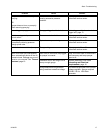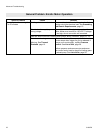
Advanced Troubleshooting
312667K 19
Basic electrical problems. Motor overheated. Allow motor to cool for 45 minutes. Retry.
Electrical outlet is damaged. Reset building circuit breaker or replace fuse. Try
another outlet.
Check electric supply with volt meter. Meter must
read 85 to 130V AC. If voltage is too high, do not
plug sprayer in until outlet is corrected.
Control board leads are
improperly fastened,
improperly mated, or
corroded.
Replace any loose terminals. Make sure all leads
and harnesses are firmly connected.
ProX7 and ProX9: Check pressure control
harness connection on front side of drive housing.
Clean control board terminals. Securely reconnect
leads.
Motor brushes are worn. Check length of BOTH brushes (brushes do not
wear evenly on both sides of the motor). Brush
length must be 0.25 in. (6.4mm). If brushes are
worn replace motor using Motor Kit, page 28.
Motor armature commutator
damaged.
Check for burn spots, gouges and extreme
roughness. If damaged or if shorts are evident,
replace motor using Motor Kit, page 28.
Fuse is blown. Find cause for blown fuse before replacing. Turn
the motor fan to check for a locked gear or pump.
Use a continuity meter to check for a short to
ground caused by a pinched wire.
ProX7 and ProX9: Replace the fuse with correct
fuse kit. See List of Kits, page 28.
X5 and X7: The fuse is not replaceable. Replace
control board. See List of Kits, page 28.
Motor armature shorting. Check for shorts. See Motor Diagnostics, page
25. If shorts are evident, replace motor using
Motor Kit, page 28.
Motor armature open circuit. Check motor leads for continuity. If open circuit,
check brushes. Use Motor Kit to replace motor.
See List of Kits, page 28.
Control board damaged.
CAUTION: Do not perform
control board diagnostics until
you have determined the
armature is good. A damaged
armature can burn out a good
control board.
See Control Board Diagnostics, page 27.
Replace control board if damaged using Control
Board Kit, page 28.
Specific Problem Cause Solution


















